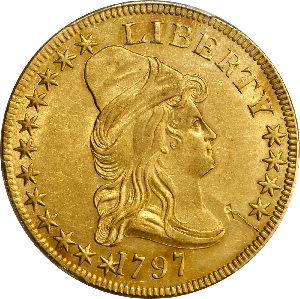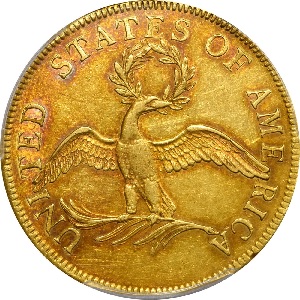1797 Capped Bust Small Eagle $10 Eagle
The Capped Bust $10 eagle design with the small eagle on the reverse lasted only three years. The final issue, the 1797, is considered the second rarest of the short-lived series, behind only the 1795 with 9 leaves variety.(1)
All 1797 eagles with the small eagle reverse were struck from a single pair of dies. The published mintage was a miniscule 3,615 pieces, but modern studies place the actual production as low 1,250.(2)
The 1797 obverse has 16 stars, uniquely (and somewhat awkwardly) arranged. The 1795 issues had 15 stars because at that time there were 15 states (Vermont and Kentucky were the first states to join the Union after the original 13). The 1796 eagles had 16 stars, following the admission of Tennessee. These stars were aesthetically arranged in an 8 left and 8 right pattern, made possible by relocating the word “LIBERTY” to the left of Miss Liberty’s cap. In 1797, “LIBERTY” was moved back to its original location in front of the cap, leaving not enough room on the right side of the coin for 8 stars. To adjust, the engraver placed 12 stars on the left and four on the right.(3)
Scholars speculate the engraver originally intended to place five stars on the right side, but decided not to because the die was cracking where the fifth star was to be placed. Instead, he “shoehorned” 12 stars on the left side. This arrangement was so crowded the 12th star actually touches the date.
Fascinating Fact: The finest known example of the 1797 Capped Bust Small Eagle $10 eagle was auctioned off in 1864 for $51. In 1944, the same piece brought $290. By 2013, it was sold for nearly $300K.(4)
As one of the few representatives of the earliest United States gold coin flagship, the $10 eagle, the 1797 Small Eagle understandably has one of the finest value appreciation rates on record. For collectors with plenty of money to spend, the biggest challenge will be finding for sale an example of this historic treasure.
| Estimated survivors in all grades: 60 ?
The survivor estimate from PCGS represents an average of one or more experts' opinions as to how many examples survive of a particular coin in all grades. Survival estimates include coins that are raw, certified by PCGS, and certified by other grading services. Learn more at PCGS. |
| PCGS Rarity Scale: 8.4 ?
The 'PCGS CoinFacts Rarity Scale' assesses the relative rarity of all U.S. coins, based on estimated surviving examples. The scale runs from 1.0 to 10.0. The higher the number, the rarer the coin.
Learn more at PCGS. |
| Click HERE to check for availability on eBay** |
Preview of eBay selection (very tough to find - be sure to also check the HERE link above):
 |
 |
| Trendline Avg = 13.96 | GOOD |
Historic Value Trend Charts:
| Last updated 9-6-24 | Return to Key Date Coin List | |
| There are no Common Date comparisons for this coin. | ||
|
|
||
| Download Charts to Your Computer | ||
Sources
1. PCGS. Type 1, Small Eagle.
2. Stack's Bowers Galleries. 1797 Capped Bust Right Eagle. Small Eagle. Aug 2020 Auction.
3. PCGS. 1797 $10 Small Eagle (Regular Strike).
4. Heritage Auctions. 1797 $10 Small Eagle. Jan 2013 Auction.
**Many very fine coin dealers sell on eBay. At any point in time, there may be over one million search results for United States coins. This includes quite a few of the recommendations on our Key Date Coin List.
If you’re thinking about purchasing a rare coin, eBay is certainly worth a look. For your convenience, the links from this site to eBay are coded to bring up only coins certified by PCGS and NGC.
As is always, always the case, never buy a valuable coin from a seller whose trustworthiness cannot be verified. Learn more about this at our chapter Best Places to Buy Coins, which also has a section on doing business on eBay.
In the interest of full disclosure, Rare Coins 101 receives a small commission anytime someone connects to eBay from this site and purchases something.
Coin images by Stack's Bowers Galleries.


